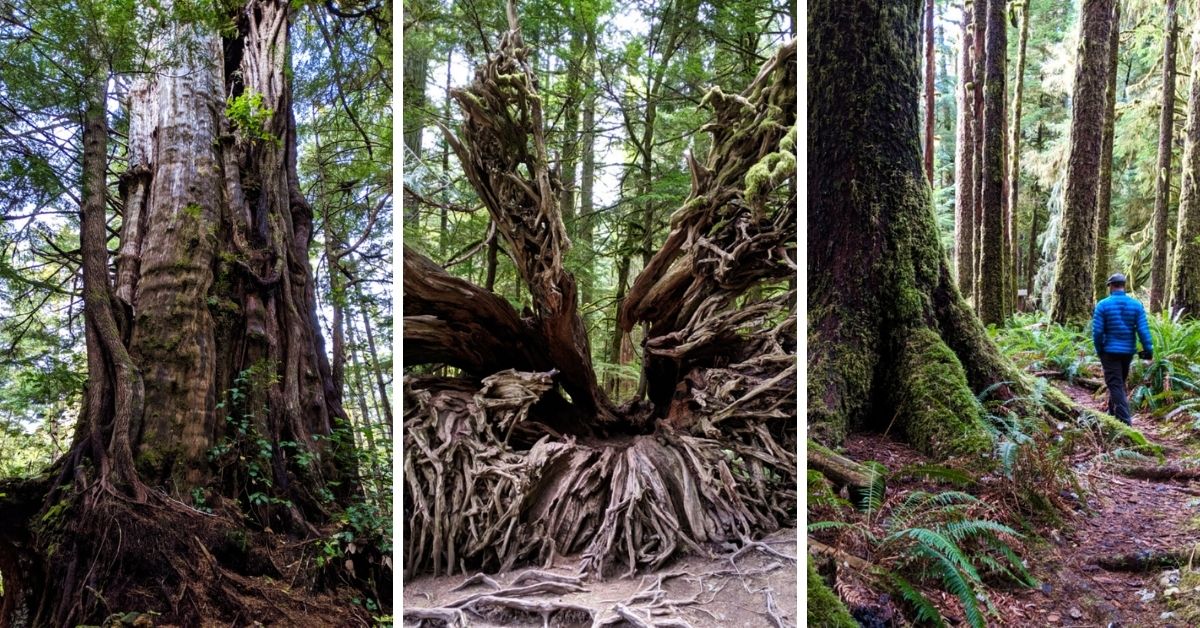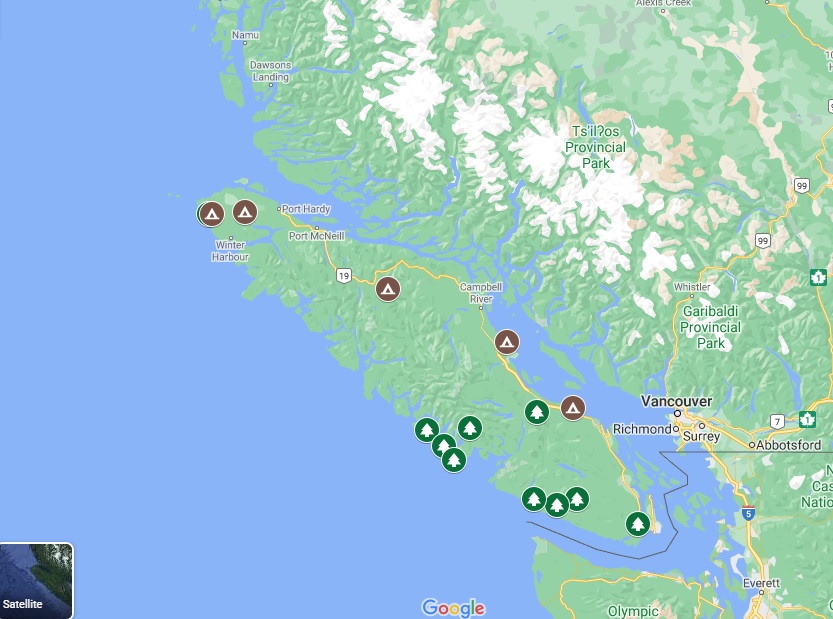With a huge amount of rainfall and a relatively mild climate, Vancouver Island is the perfect place for trees to grow. And grow they do, with some of the biggest trees in Canada found in the misty valleys of Vancouver Island.
Seeing big trees is a high priority for many visitors to Vancouver Island. And quite rightly, it should be. To admire a living creature much larger and older than any of us is a humbling and sometimes even spiritual experience.
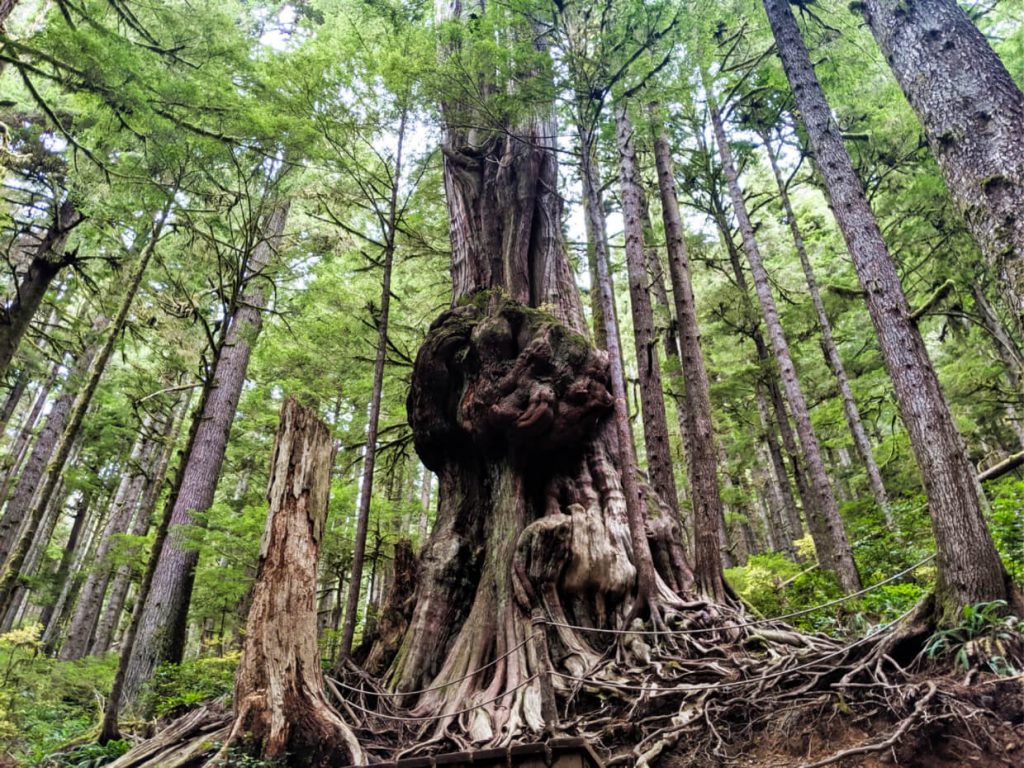
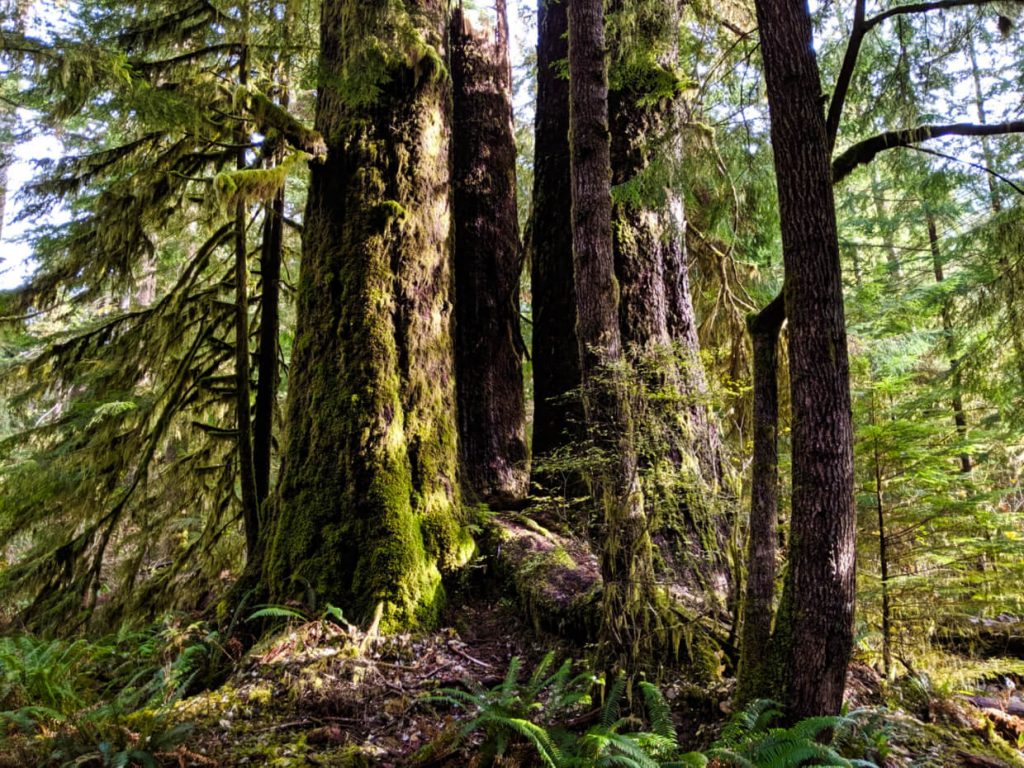
Finding Big Trees on Vancouver Island
Luckily, there are many opportunities to see and admire big trees on Vancouver Island. This post includes 15 different places across Vancouver Island where it is possible to see incredible old growth trees.
All of the following places can be visited year round, the majority are completely free to visit and most are accessible to anyone with average fitness.
I recommend each and every one of these destinations based on thousands of kilometres of research around Vancouver Island over a number of years. I have also visited many of these trees multiple times.
This post was originally published on offtracktravel.ca. The below text includes affiliate links. If you purchase a product through one of these links, I may receive a small commission at no extra cost to you.
Need to Know – Big Tree Etiquette
When exploring nature, it is so important to be aware of your impact and make steps to reduce it as much as possible. Doing so helps maintain sensitive forest ecosystems and preserve these magical groves for future generations.
Remember – “Even giants don’t like their toes stepped on” [Sign at Harris Creek Spruce near Port Renfrew]
Here’s how you can help:
- Always pack out what you pack in. Don’t leave anything behind when exploring these big tree groves. That includes granola bar wrappers, banana peels, apple cores, water bottles and hair ties (some of the most common things we have seen left in nature)
- Stay on the marked paths and boardwalks. Tramping roots and nutrient rich soil can cause permanent injury to trees and surrounding vegetation. These trees are more fragile than you may expect.
- Never climb over fences. Some of the trees mentioned below are protected by rope or wooden fences – always stay behind them.
- Follow weather warnings. Being around big trees can be dangerous during high winds. Check the weather before visiting. Leave the area immediately if a storm is approaching.
- Respect all signage. Storm damage can cause big tree groves to close temporarily or even permanently. If an area is closed, respect the signage and explore elsewhere.
- Don’t sit or climb on the trees. As tempting as it may be to get an impressive photo, climbing trees can irreparably damage the bark. Admire the trees from ground level and leave the tree as you found it.
Following the above guidelines also respects the unceded traditional land of First Nation peoples where many of these trees are located.
For more info about reducing your impact on nature, check out the Leave No Trace Canada website.
Big Tree Groves on Vancouver Island
Ready to see some big trees on Vancouver Island? Here are my top picks to visit and why. There’s a map below showing the location of each.
I have ordered these big tree groves in respect to their accessibility. The first listed is the easiest to access and explore.
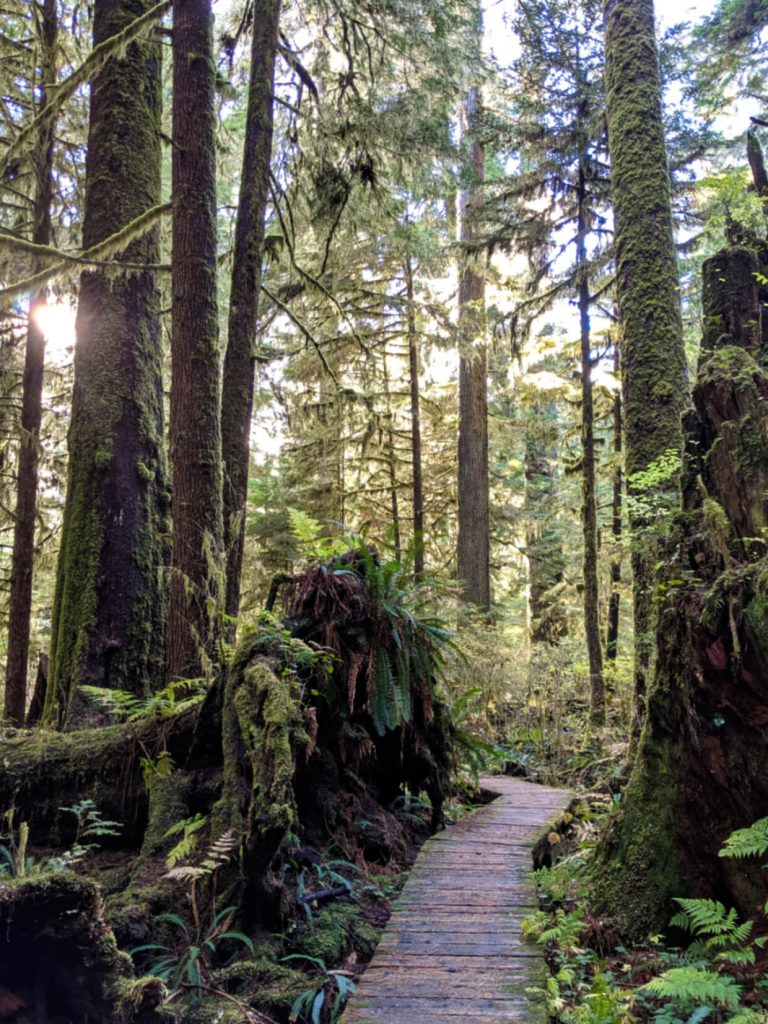
An important note
This list of big tree groves on Vancouver Island is not exhaustive. I have, however, chosen to include only big tree groves that have been, at this time, developed for visitors.
This means that all listed groves have basic facilities such as parking and established trails or boardwalks. In addition, almost all (with one exception) of these Vancouver Island big tree groves are located on protected lands.
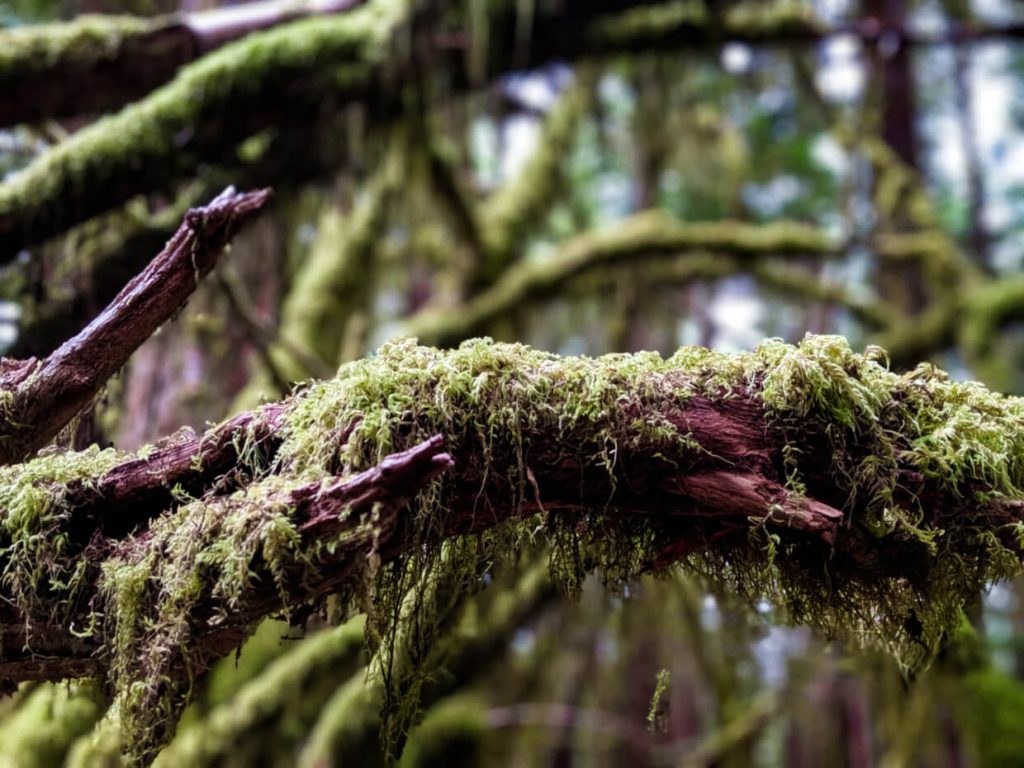
Cathedral Grove
Located in MacMillan Provincial Park, Cathedral Grove is Vancouver Island’s most visited old growth forest. It’s a convenient place to see lots of big trees very quickly. Some of the giant Douglas Fir trees in Cathedral Grove are 800 years old.
The biggest, found on the short but aptly named ‘Big Tree Trail,’ has a circumference of over 9 metres. A popular stop on the way to Tofino, Cathedral Grove is located right on Highway 4, between Port Alberni and Coombs.
Please note – Cathedral Grove is currently closed (April 2020 onwards). Check the BC Parks website for updates.
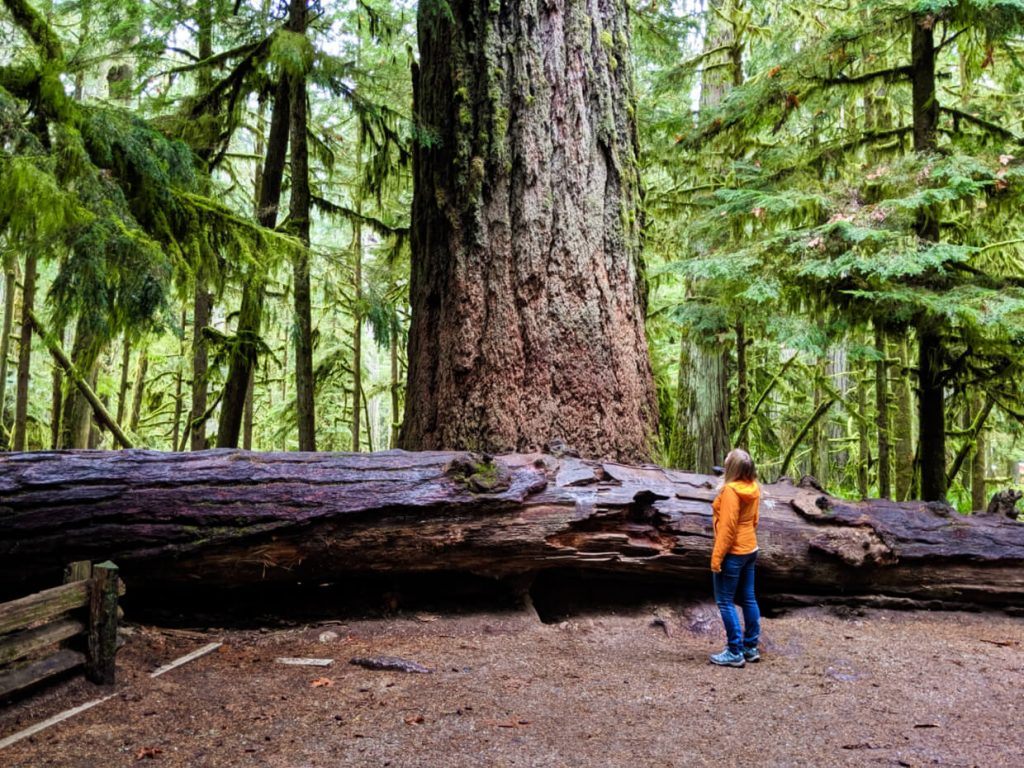
Goldstream Provincial Park
Despite being just a short drive north of Victoria, Goldstream Provincial Park offers the chance to hike alongside ancient Douglas Fir and Western Red Cedar on the way to Mount Finlayson.
The views from the 416m peak are almost as impressive. Goldstream also offers waterfall viewing and the chance to see salmon spawning in fall.
Giant Cedar Trail, Canoe Creek
Cathedral Grove isn’t the only place to see big trees on the way to Tofino. A short walk on the Giant Cedar Trail will reveal a number of huge cedar trees, with the most magnificent being found within 500m of the road.
The Giant Cedar Trail itself is a little overgrown and not as manicured as those found in Cathedral Grove, but you’re likely to have the beautiful cedar trees here all to yourself.
The Giant Cedar Trail is one of my most recent discoveries on Vancouver Island, something I’m a little embarrassed about since it is right on Highway 4! It is well signed too, just look for the Canoe Creek / Giant Cedar Trail signs about 19km after the Taylor River Rest Area when approaching from the east.
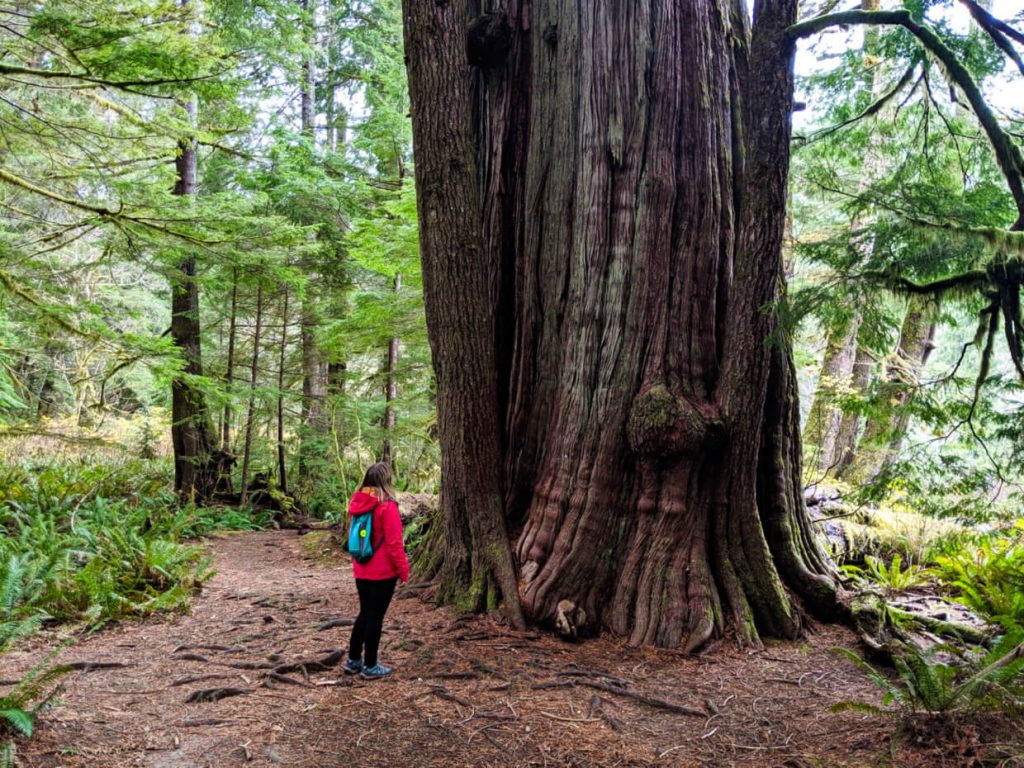
Ancient Cedars Loop
The Ancient Cedars Loop is part of Ucluelet’s wonderful Wild Pacific Trail. This section takes only 15-20 minutes to walk and is easily accessible straight from the highway.
For such low effort, the reward is surprisingly high with large cedar trees appearing next to the trail almost immediately. Some are over 800 years old.
Being so close to the ocean, the trees found along the Ancient Cedars Loop have had to regularly withstand extreme weather conditions including gale force winds and lightning storms.
Be sure to extend a little further along the Wild Pacific Trail to see the spectacular coastal scenery that characterizes this area.
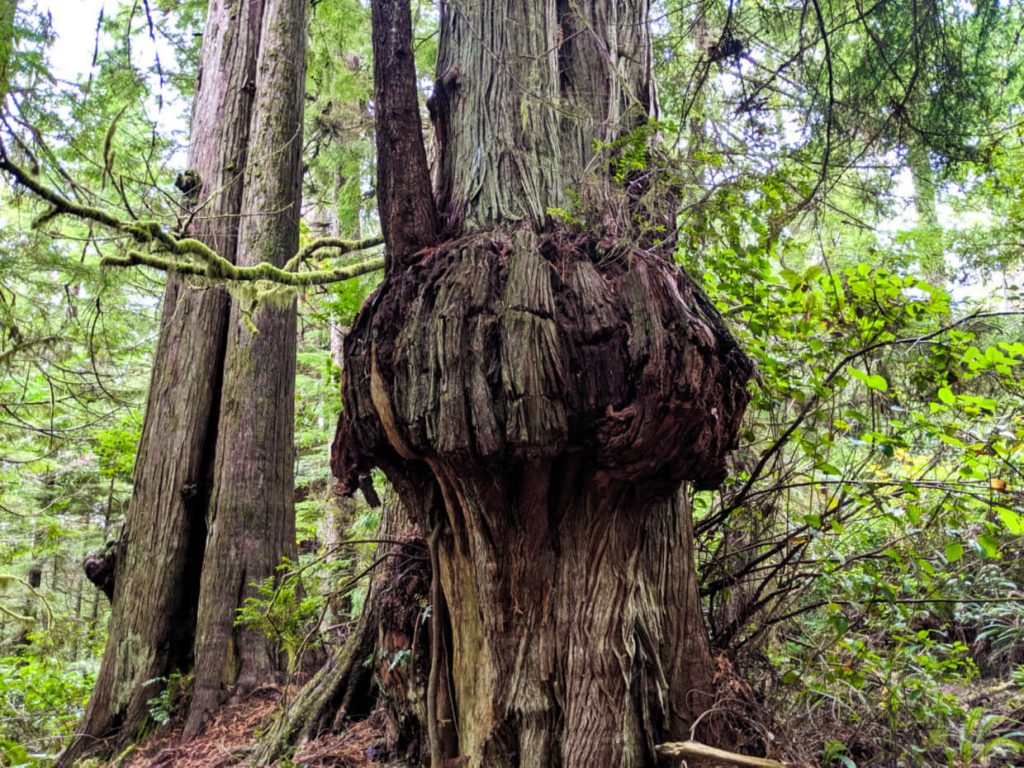
Rainforest Trails, Pacific Rim National Park
The Long Beach Unit of Pacific Rim National Park showcases Vancouver Island’s coastal scenery in its many forms, from windswept sandy beaches and rocky coves to bogs and temperate rainforest.
The latter can be explored on two short boardwalk trails, appropriately named ‘Rainforest A’ and ‘Rainforest B.’
Both Rainforest trails are 1km in length and feature undisturbed old growth forest, with big trees, mossy undergrowth and thick ferns. There are a number of steps to climb on either trail.
Note: A Canada Parks Pass is required to hike the Rainforest trails mentioned above.
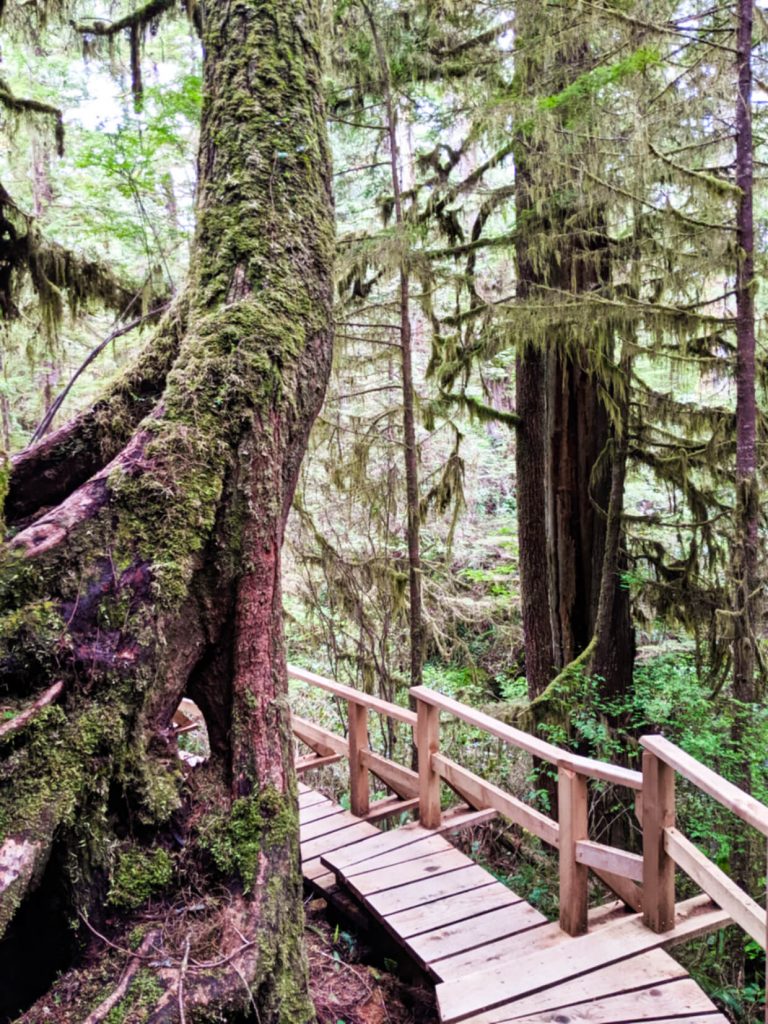
Meares Island – Wah’nah’juss Hilth’hooiss
Home to some of the oldest trees in British Columbia, Wah’nah’juss Hilth’hooiss (also known as Meares Island) is a Tribal Park on the West Coast of Vancouver Island.
Once slated to be clear cut, the Tla-o-qui-aht and Ahousaht First Nation people protested and ensured the forests of Meares Island remain protected for generations to come.
Accessible via a water taxi or kayak paddle from Tofino, the Big Tree Trail offers a glimpse of the incredible old growth magnificence of Meares Island. The Hanging Garden Tree, for example, is at least 1000 years old and is a host to 15 other species of plants and trees.
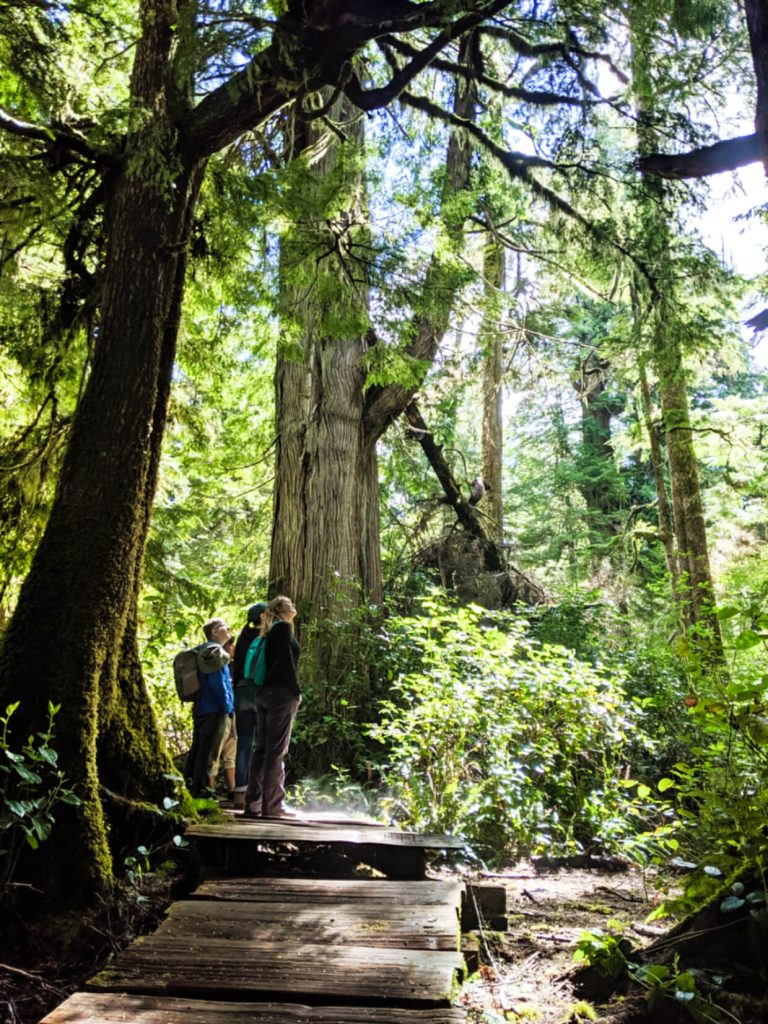
Harris Creek
The Port Renfrew area is host to many huge trees, with some being known but plenty certainly still not. One of the most easy to access is the Harris Creek Spruce, a giant Sitka situated in an old growth grove just off the Pacific Marine Route to Cowichan Lake.
This mossy grove is found around 8km north of the Lizard Lake Recreational Site. There’s a lay by as well as an off road parking area. The Harris Creek Spruce is accessed via a very short flat trail.
To see an even bigger specimen, head to the San Juan Bridge Recreation Site to see the San Juan Sitka.
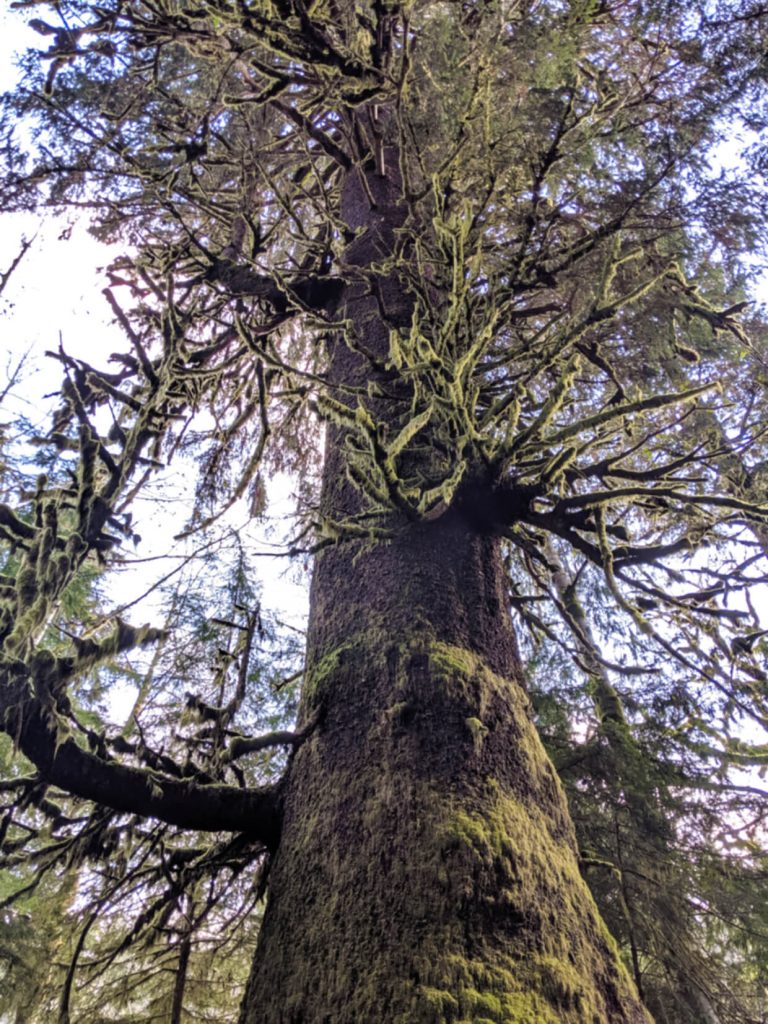
Avatar Grove
One of Vancouver Island’s most recently developed big tree groves, Avatar Grove offers two short trails through an old growth forest filled with cedars and firs.
The northern route is home to “Canada’s Gnarliest Tree,” a cedar with a gargantuan burl (knotty growth). The southern boardwalk loop trail also has its share of gnarly trees, with my favourite being the one pictured below.
Avatar Grove is located about 10km north of Port Renfrew, with the last 6km on unsealed industrial roads.
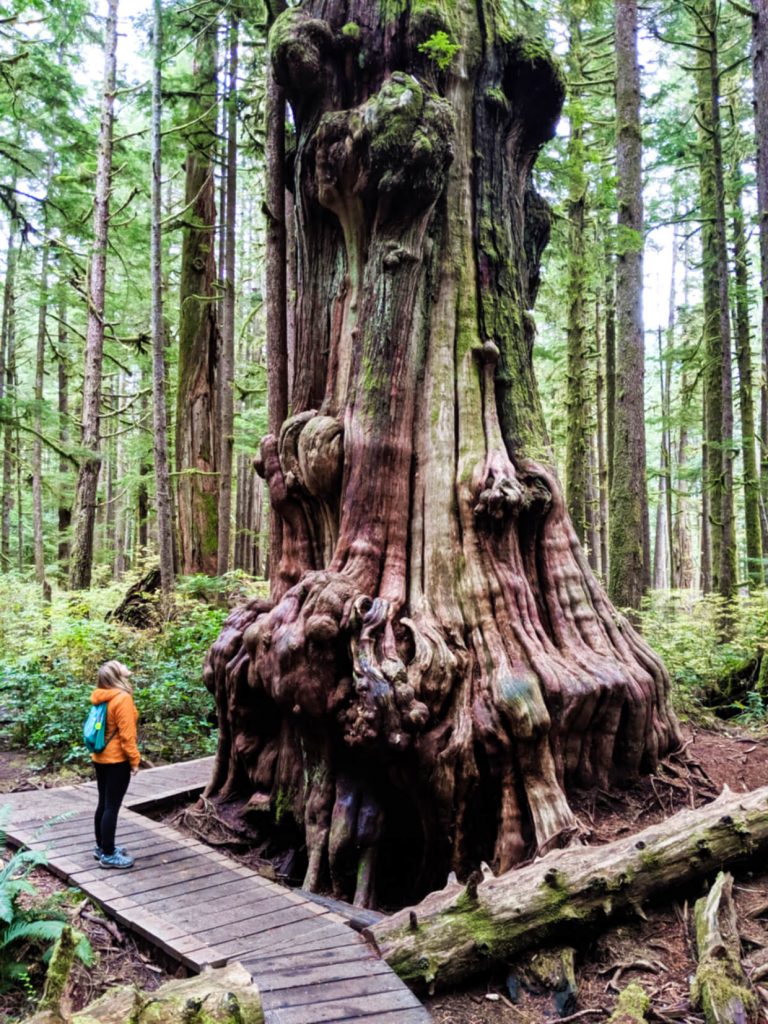
If you have a vehicle with decent clearance and good tires (AWD or 4X4 would be beneficial), I’d recommend also visiting Big Lonely Doug, Canada’s second tallest Douglas Fir. It sits in a clear cut just fifteen minutes from Avatar Grove.
Drive north on Gordon River Road and then take a left on Edinburgh Main. The road is good for the most part but there is a steep hill close to Big Lonely Doug that could be challenging for smaller vehicles.
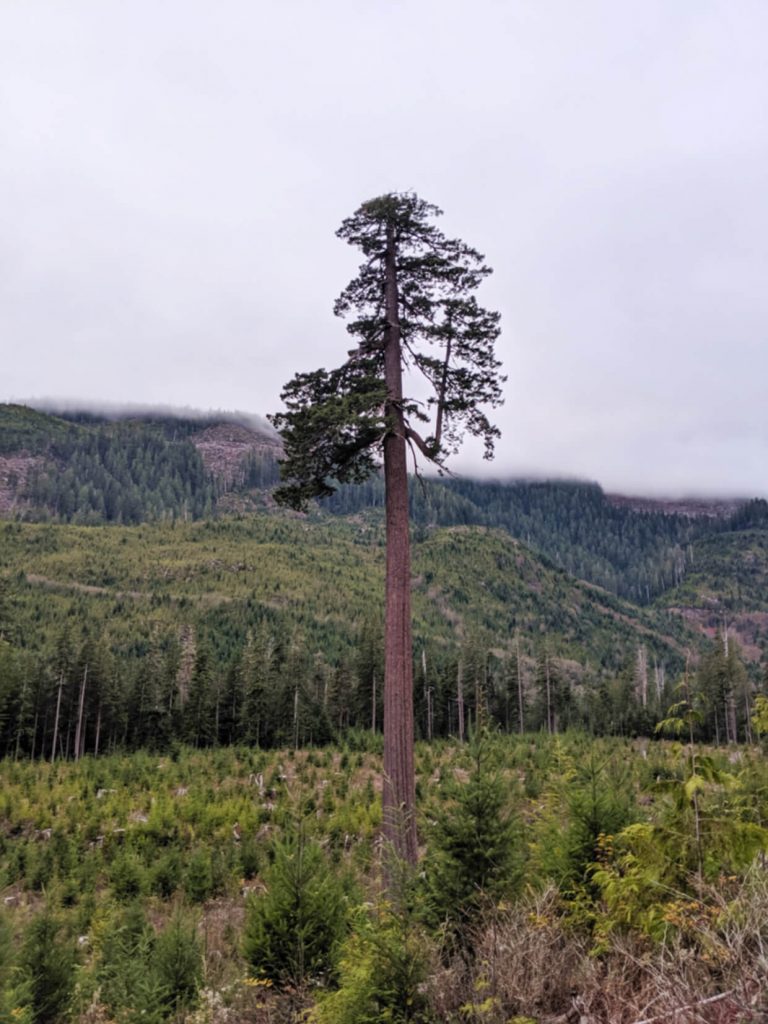
Cape Scott Provincial Park
There are many reasons to visit beautiful Cape Scott Provincial Park, at the very northwestern edge of Vancouver Island.
Besides the magnificent sandy beaches and fascinating historic settlements, the park also features extensive old growth forest. The flagship Cape Scott Trail passes a massive Sitka Spruce on its way to beautiful Nels Bight beach.
Cape Scott Provincial Park is 70km west of Port Hardy, a two hour drive on gravel logging roads.
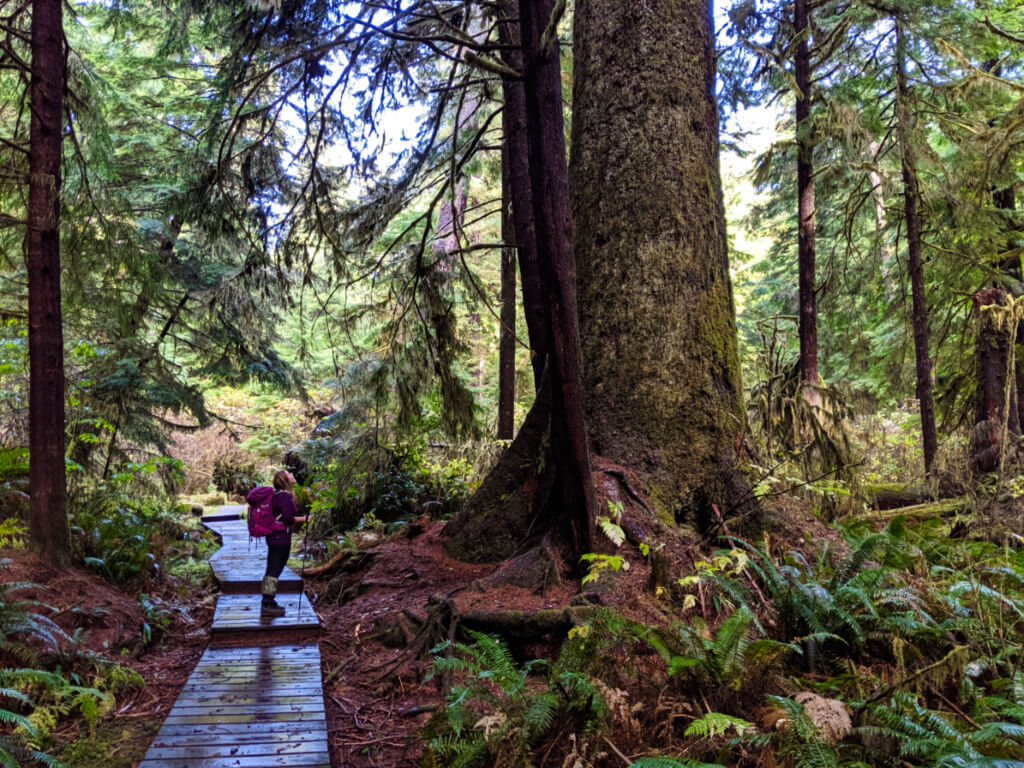
Carmanah Walbran Provincial Park
Remote and wonderfully wild, Carmanah Walbran Provincial Park rewards adventurous visitors with access to one of the most impressive old growth tree groves in British Columbia. Home to the largest spruce trees on Vancouver Island, some reach as high as 95 metres. Other trees in the park are estimated to be around 1000 years old.
Carmanah Walbran is one of my favourite places in all of British Columbia, but the area must be explored with care. The trails through the impossibly lush forest valley are rugged, featuring uneven and slippery boardwalks.
Carmanah Walbran is a two hour (92km) bumpy drive on logging roads west from Lake Cowichan.
Driving the backroads of Vancouver Island
The last three groves mentioned above are only accessible via Vancouver Island’s network of gravel (unsealed) industrial roads.
When driving on these roads, it is imperative to drive defensively. Be ready to meet (and give way to) loaded logging trucks and other large industrial vehicles at any time.
Make sure you have an adequate spare tire and be prepared to use it. Drive slowly and carefully. Bring extra food, water and clothing in case of unexpected delay. Expect to have zero phone signal while exploring the backroads.
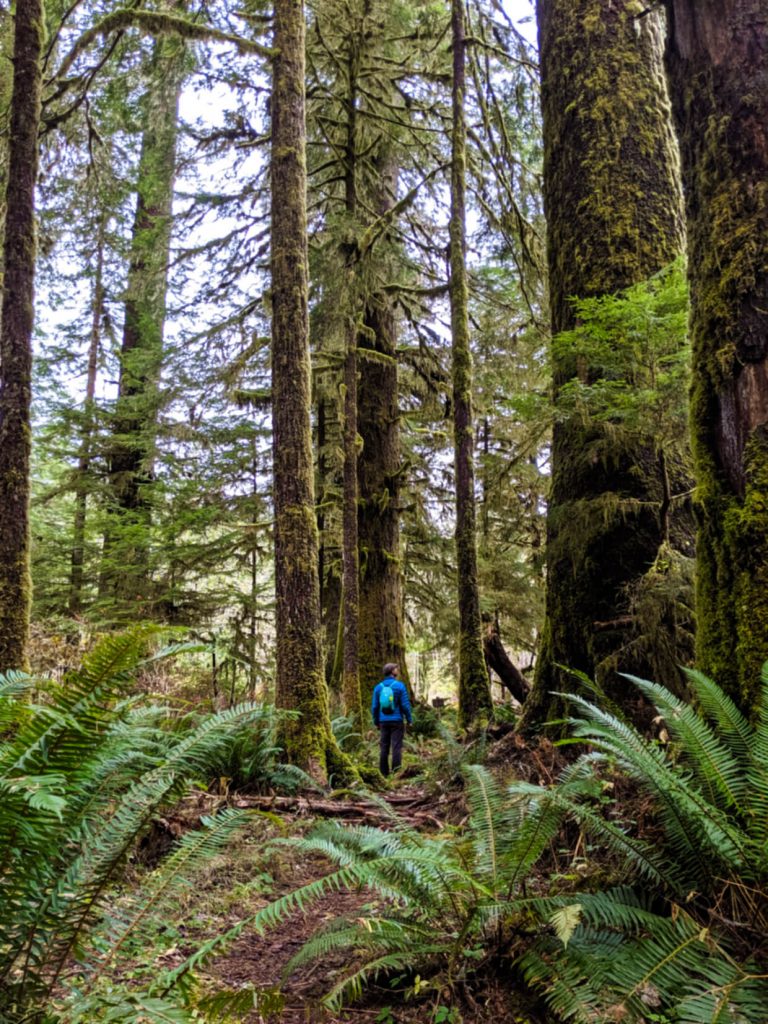
Campgrounds Featuring Big Trees on Vancouver Island
Not only can you see big trees on Vancouver Island, but it is also possible to camp under them too! The following campgrounds all feature large trees within their boundaries, making it possible to both sleep under the stars and a canopy of old growth.
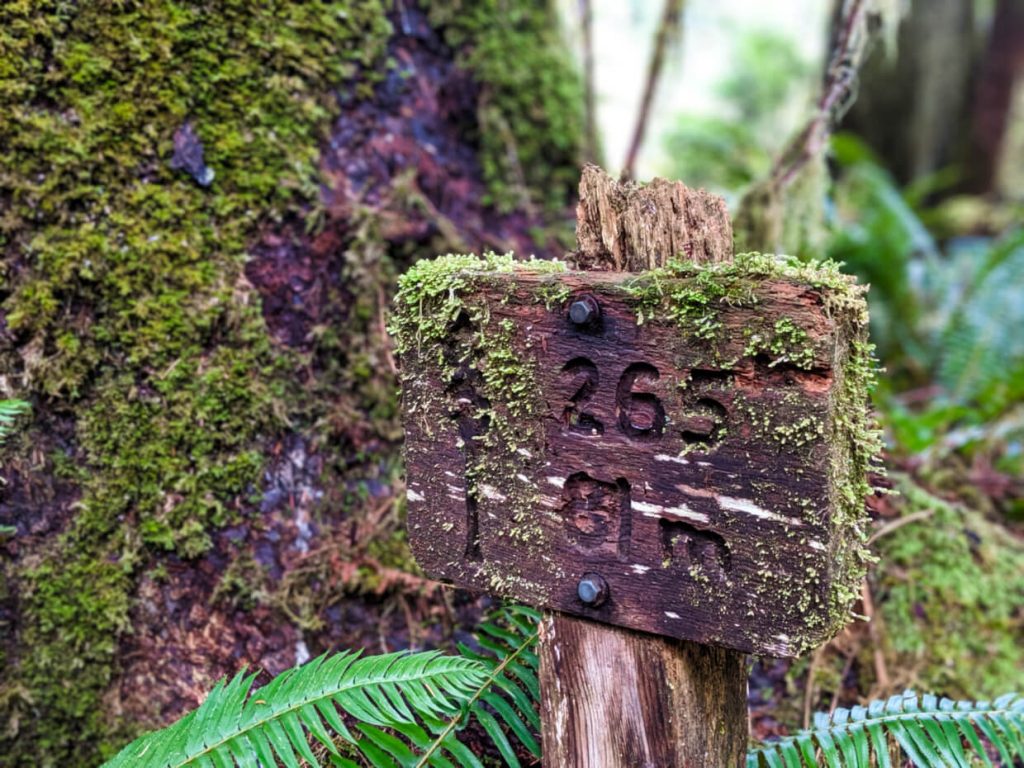
Rathtrevor Provincial Park
Set into an old growth Douglas Fir forest, Rathtrevor Provincial Park hosts one of the most popular campgrounds on Vancouver Island. The popularity is well deserved, with a 2km long scenic beach to explore in addition to the impressive forest.
Reservations are required to get one of the 250 vehicle accessible or 25 walk-in camp spots in summer. Be sure to book early! There is also a day use area.
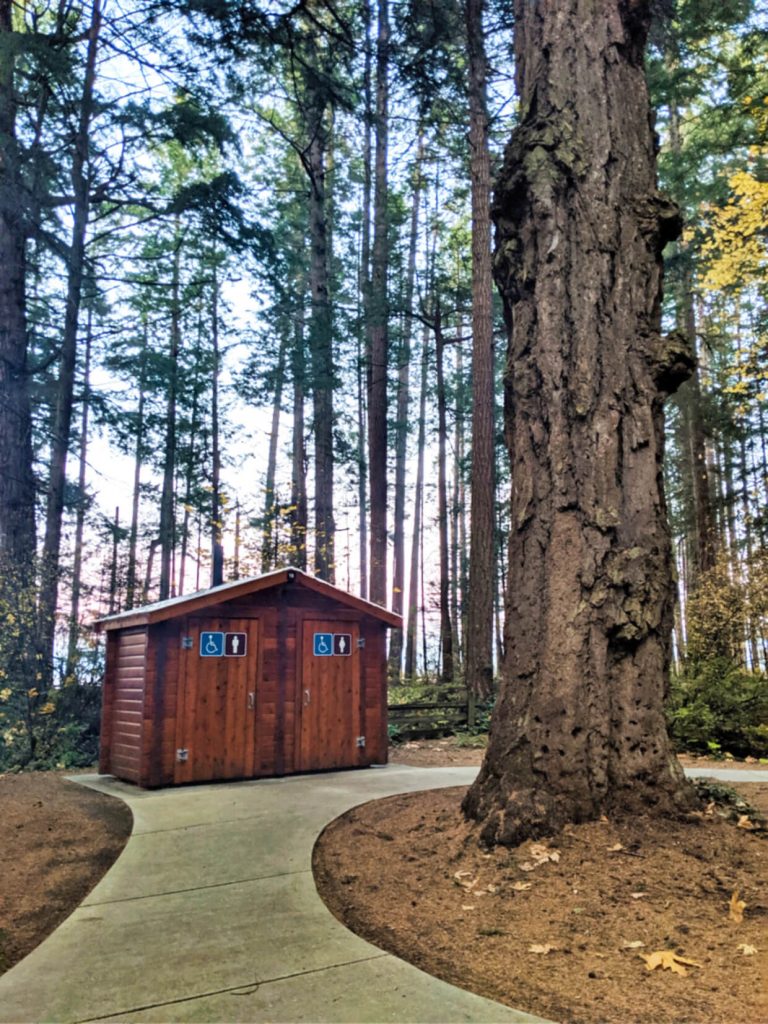
Kitty Coleman Provincial Park
While the affordable oceanfront campsites at this volunteer-run provincial park are the star attraction for many, there is also a huge 500 year old Douglas Fir tree to admire.
Be sure to stop and take a walk through this small park or stay overnight and enjoy the views. Campsites are available on a first come, first serve basis only.
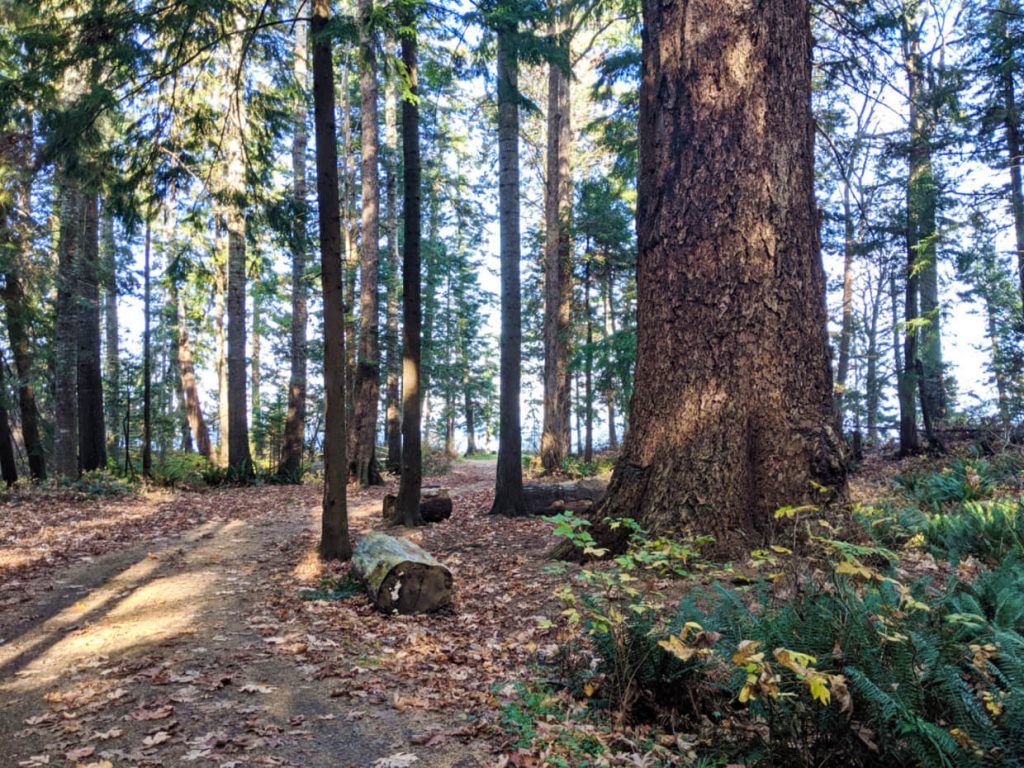
San Josef River Recreation Site
Located just outside of the entrance of Cape Scott Provincial Park, this Recreation Site is set into a grove of old growth spruce trees next to the river. The campground itself is a little run down (some of the picnic tables have pieces missing, for example), but it doesn’t take away from the magnificence of the towering trees.
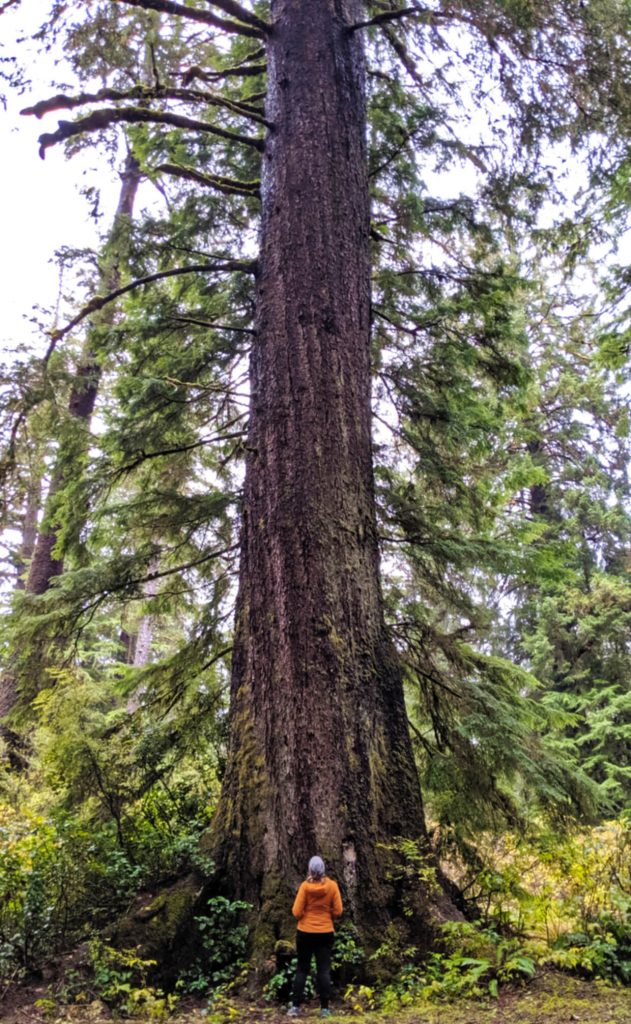
Schoen Lake Provincial Park
A short drive on a narrow dirt road from Highway 19 near Woss, Schoen Lake features a compact lakeside campground with 9 sites. The campsites closest to the lake are surrounded by large old growth trees. These sites also offer incredible views of impossibly rugged Mount Schoen (1860m) across the water.
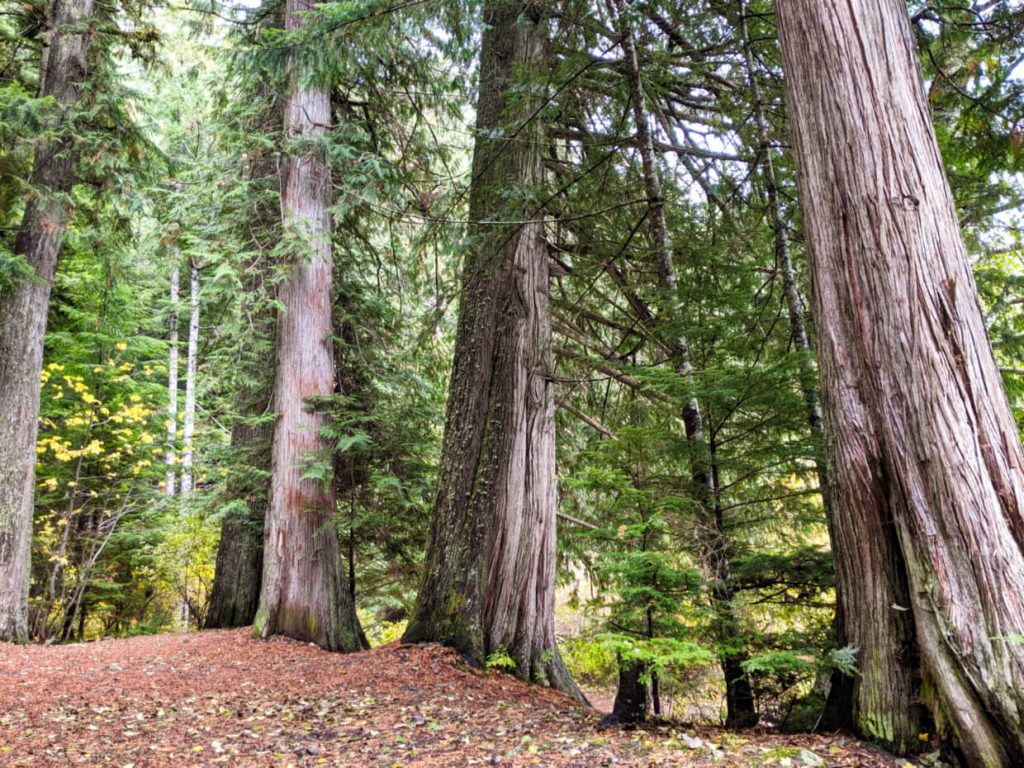
Nahwitti Lake Recreation Site
The 11 rustic campsites at Hepler Creek are surrounded by beautiful old growth balsam and hemlock trees. The trees here aren’t the widest you’ll find on Vancouver Island. They are, however, incredibly tall, creating an impossibly high canopy above the camping sites.
Situated on the southern shore of Nahwitti Lake on the unsealed Holberg Road, this Recreation Site makes a good stopover when heading towards Cape Scott Provincial Park.
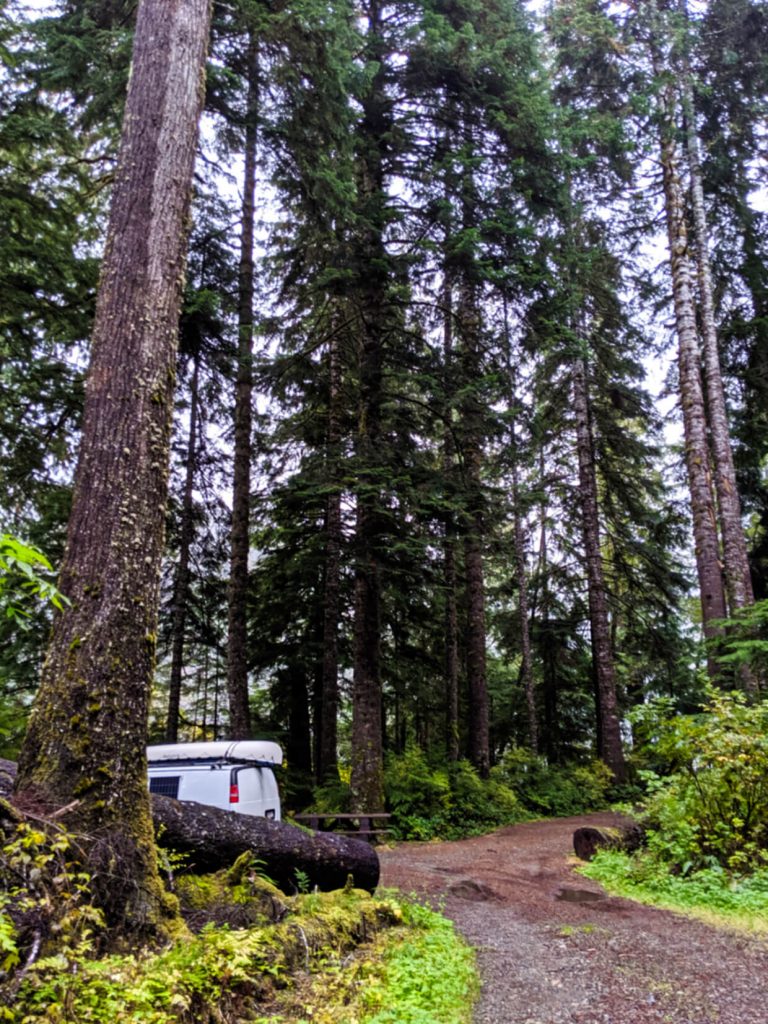
Other campgrounds
It is also possible to camp overnight in Goldstream Provincial Park, Cape Scott Provincial Park, Carmanah Walbran Provincial Park, Pacific Rim National Park and on Meares Island (all mentioned above).
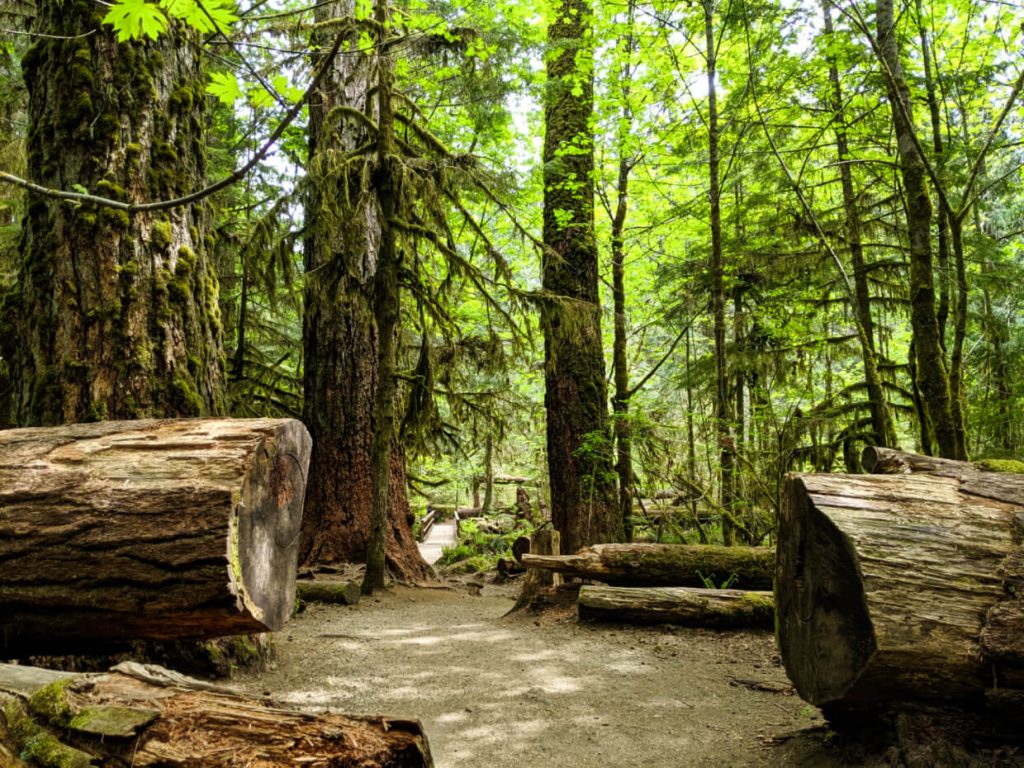
How to Find Big Trees on Vancouver Island
As previously mentioned, this list does not include every single large tree grove on Vancouver Island. There are plenty more. Most of them, however, are more remote than those listed here.
If you’re interested in visiting them, I’d recommend purchasing a Vancouver Island Backroad Mapbook. Not only does this essential guide pinpoint the location of each big tree, but it also will help you navigate Vancouver Island’s complex logging road network.
